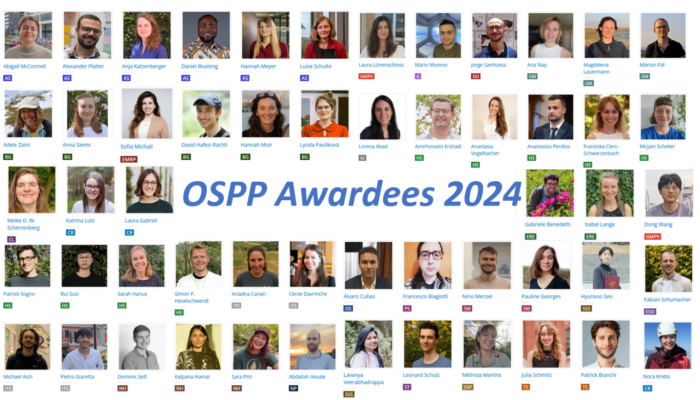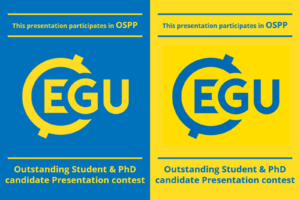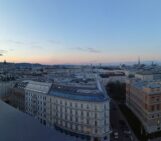
Hi there, I am Marius, an Outstanding Student and PhD candidate Presentation (OSPP) awardee from 2023 for the Geodesy Division. I want to share my experiences on the competition with you. EGU’s General Assembly is approaching, and many of you are probably preparing your contributions and thinking about how you will present your results in a few weeks. I want to give you an overview of Do’s and Don’ts to help you win an OSPP award. The OSPP is one of EGU’s special awards to foster high-quality poster and PICO presentations and is awarded in each division.
If you win the competition, this is rewarded with a certificate and your picture on the EGU Website and on the screens during the following General Assembly. More interestingly, you are invited to submit a paper (you as the first author) free of cost to one of the EGU journals, and you get a conference fee waiver for the next EGU General Assembly. First, I want to answer the question of why it is worth participating. Yes! For me, the reason was to have minimal additional work, resulting in high visibility and better interaction during my session. In general, OSPP contributions are like any other contribution; people will come along and engage in discussions with you. In my experience, OSPP contributions spark more discussions and get more feedback on their work. So, it’s already a win there!
So, hopefully, you are now thinking about what you should do to win the OSPP, gain more visibility in your community, and win that conference waiver so you can come to Vienna again next year. Here are some DO’s and DON’Ts:
Do make your poster count
Your presentation and interaction with the judges will have a large influence on the scores they will give you in the evaluation, but your presentation material matters too. Make it look nice and attractive to people. Don’t make them read paragraphs on paragraphs before understanding what the key message of your presentation is; make it directly visible. Choose figures that express themselves rather than having to explain all the details before someone can understand them.
Do show presence
In other words, don’t hide. Make eye contact, and smile at passing audiences, they might want to start a conversation with you and just need a little nudge to start. Be present at your poster during the designated time of your poster session. Find a good spot to stand so that people can identify you as the presenter. At the same time, keep in mind that you should not block people from viewing your material and present your work proactively. This brings me to the next point.
Do engage in discussion
No matter if people are evaluating your poster (it is hard to tell anyway), engage in discussion. Explore new perspectives on your own work. This has two fundamental advantages. One, you will improve your own understanding of the topic and that of everyone else who is listening, which might lead to a breakthrough or future collaboration. And secondly, if a judge is listening, they will be impressed by that.
Don’t get defensive
People might criticize your work, which is sometimes hard to handle, especially if there is a language barrier or cultural differences, which might make comments appear rude, even though they were meant well. If that happens, don’t get defensive; engage in the discussion and try to understand why the person thinks that way. You may gain valuable insights or help them see a new perspective they hadn’t considered.
Do interact and network
PICO and poster presentations are interactive, so do interact. Usually, people listen first to what you want to present, but allow them to interrupt you with questions and engage in the discussion even though it might divert from the original topic a bit. And get to know the people who are interested in your work. What are they working on? Poster discussions, especially at the General Assembly, are a great opportunity to increase your network.
Don’t hide your display material
EGU gives you space for an online presence; use that space. Upload additional presentation material but not blindly. Think about who is reading the online material. Probably someone who is interested in your presentation but didn’t get a chance to talk to you during your presentation, so it should be self-explanatory but not too long! There are many presentations at EGU. Make it accessible by including a QR code in a visible spot on the display material in your presentation.
Don’t miss out
Finally, don’t miss out on the OSPP award. There are not many conferences that offer young researchers such a chance for visibility, so use this chance. Especially as the OSPP Award grants visibility outside your own division and in your own field. Visibility is important to grow your network, and your network will influence your chances in your career. It is not much work to participate in the OSPP award, but there is a lot to gain.

OSPP label (blue PNG, yellow PNG) that should be added to your presentation material
Don’t be quiet about participating in the OSPP
It is important that people know that you are participating in the OSPP award! There are
dedicated judges who will visit your presentation, but any registered EGU participant is invited to vote on OSPP presentations (as long as they are not eligible to participate in the OSPP award themselves or co-authoring the presentation/ share the same affiliation). So, bring some attention to it by adding the OSPP label to your presentation, adding a QR code to the online presentation pages, and telling people visiting your presentation that you are participating.
Finally, I want to clarify who is eligible to participate in the OSPP competition. The criteria for applying for the award are straightforward. You must be a first author and personally present a poster or PICO at the General Assembly. In addition, you must be a current (BSc/MSc) student, PhD candidate, or alternatively a recent graduate (BSc, MSc, or PhD with conferral of degree after 1 January of the year of the conference) presenting your thesis work.
Moreover, it might be interesting to know how to apply. This is no effort; some of you might have ticked the box to do so when you submitted your abstract. If you didn’t or don’t remember, don’t worry. The letter of schedule (sent out on 14 Mar 2025) informs us whether your contribution is a Poster or Pico and includes a link to the registration. The deadline for that is one week after the letter of schedule has been sent out. If you missed out to participate in the upcoming GA, make sure to register next year.
For more information on how the contributions are judged, please check here.
Edited by Rebekka Steffen & Kiana Karimi




